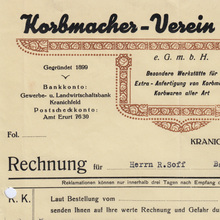A bold italic sans, shown by J.H. Rust & Co. in Vienna in 1875
under the generic name Halbfette Cursiv-Grotesque.
Created either by Rust & Co. or by Aigner & Gutenberg, Vienna, with
Cyrillics. Rust & Co. sold both type and matrices, in six sizes
(8pt–28pt). By 1900, this design was carried by at least 20
foundries in Germany, Austria, and Switzerland; incl. AG für
Schriftgießerei und Maschinenbau, Bauer, Berger, Brendler, Brötz &
Glock, Drugulin (as Steinschrift Cursiv, w/ Cyrillics,
probably added in-house), Flinsch, Klinkhardt, Kloberg, Krebs (as
Kursiv-Steinschrift), Haas, Rudhard’sche Gießerei,
Schelter & Giesecke, Stempel (as Halbfette
Kursiv-Grotesk), Theinhardt, Weisert, and Woellmer (w/
Cyrillics, probably added in-house). Flinsch had a 6pt size, and
Stempel added a 32pt size. A 36pt size was shown by Schelter &
Giesecke (from 1894) and by Bauer (at least from 1900). Klingspor had the design as
Steinschrift-Kursiv and added a (narrower) 36pt size.
Stempel created Linotype matrices for a 6pt size, as Grotesk
1731 and Grotesk 1732 (w/ shorter descenders.
Also carried by A. Lange & Co. and Lehmann in St. Petersburg [Reynolds].
The same (or a very similar) design was shown in the United
States by MacKellar, Smiths & Jordan in 1876 and by Cincinnati in 1878 as Italic Gothic, No.
2; by Boston
Type Foundry in 1880 as Gothic Italic, No. 2 and
No. 3; by Dickinson around 1890 as Gothic Italic
(attributed by Alastair M. Johnston and Stephen O. Saxe to
punchcutter John F. Cumming); and by Inland More…
A bold italic sans, shown by J.H. Rust & Co. in Vienna in 1875 under the generic name Halbfette Cursiv-Grotesque. Created either by Rust & Co. or by Aigner & Gutenberg, Vienna, with Cyrillics. Rust & Co. sold both type and matrices, in six sizes (8pt–28pt). By 1900, this design was carried by at least 20 foundries in Germany, Austria, and Switzerland; incl. AG für Schriftgießerei und Maschinenbau, Bauer, Berger, Brendler, Brötz & Glock, Drugulin (as Steinschrift Cursiv, w/ Cyrillics, probably added in-house), Flinsch, Klinkhardt, Kloberg, Krebs (as Kursiv-Steinschrift), Haas, Rudhard’sche Gießerei, Schelter & Giesecke, Stempel (as Halbfette Kursiv-Grotesk), Theinhardt, Weisert, and Woellmer (w/ Cyrillics, probably added in-house). Flinsch had a 6pt size, and Stempel added a 32pt size. A 36pt size was shown by Schelter & Giesecke (from 1894) and by Bauer (at least from 1900). Klingspor had the design as Steinschrift-Kursiv and added a (narrower) 36pt size. Stempel created Linotype matrices for a 6pt size, as Grotesk 1731 and Grotesk 1732 (w/ shorter descenders. Also carried by A. Lange & Co. and Lehmann in St. Petersburg [Reynolds].
The same (or a very similar) design was shown in the United States by MacKellar, Smiths & Jordan in 1876 and by Cincinnati in 1878 as Italic Gothic, No. 2; by Boston Type Foundry in 1880 as Gothic Italic, No. 2 and No. 3; by Dickinson around 1890 as Gothic Italic (attributed by Alastair M. Johnston and Stephen O. Saxe to punchcutter John F. Cumming); and by Inland in 1894 [Reynolds].
Also shown as Gothic Italic No. 1 (S&H, 1889; BB&S, c.1893), Gothic Italic No. 3 (Palmer & Rey, 1884; Marder, Luse, 1893), and Lining Gothic Italic No. 512 (ATF, 1906). Mergenthaler Linotype had Gothic Italic No. 4 around 1907 [Wilson].
Shown with additional sizes by Peignot & Fils as Antiques Italiques, 2e Catégorie in c.1907 and later also by Deberny & Peignot [Reynolds].
The sample is based on several sizes from Schelter & Giesecke’s version.
Not to be confused with the lighter and more modulated Italic Gothic.









